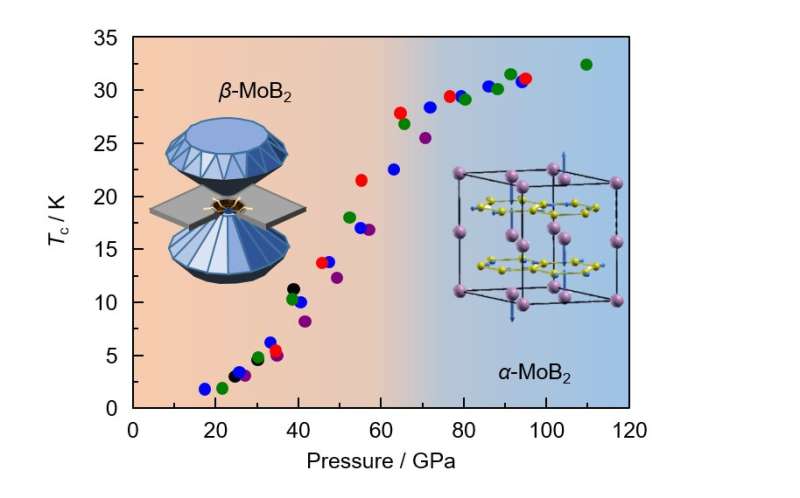This article has been reviewed according to Science X's editorial process and policies. Editors have highlighted the following attributes while ensuring the content's credibility:
fact-checked
trusted source
proofread
Superconductivity with Tc as high as 32K found in borides

Superconductors with high transition temperature (high-Tc SCs) are long-sought targets in the condensed matter physics and materials communities because of significant scientific and application values. Since the discovery of superconductivity in mercury more than one hundred years ago, only a handful of systems show Tc higher than 30 K.
Scientists at the ShanghaiTech University and their collaborators at Renmin University of China discovered superconductivity up to 32 K in MoB2 under pressure, which is the highest Tc in transition-metal borides up to now. Their findings, published in the journal National Science Review, shed light on the exploration of high-Tc superconductors in transition metal borides.
Molybdenum diboride (MoB2) is unique among the MB2 family since it is the only material that has two structural forms, α-MoB2 phase (AlB2-type) and β-MoB2 phase (CaSi2-type).
Synchrotron X-ray diffraction (XRD) measurements indicate that β-MoB2 transforms to α-MoB2 at around 65 GPa, which possesses the same crystal structure as MgB2.
"A question arises naturally: is it possible to achieve superconductivity in MoB2 under high pressure?" said Dr. Yanpeng Qi, an assistant professor of School of Physical Science and Technology at ShanghaiTech University and one of the corresponding authors.
"So, we carried out the in-situ high pressure electrical transport measurements. Superconductivity is observed at 21.7 GPa and Tc increases with pressure. Beyond the critical pressure (Pc = 70 GPa) where the structural phase transition, the growth of Tc slows down and the maximum Tc of 32.4 K is attained at P = 109.7 GPa, which is the highest pressure we exert on the sample."
Further theoretical calculations suggest that although the compressed MoB2 has a similar structure and comparable Tc with MgB2, the superconducting mechanism of the former is completely different from that of the latter: the d-electrons and phonon modes of transition metal Mo atoms play utterly important roles in the emergence of superconductivity in contrast to the dominance of p-electrons and phonon modes of B atoms in the superconductivity of MgB2.
The results shown in this work highlight the roles of transitional metals in the superconductivity in borides, which has been underestimated in borides before. Their discovery of superconductivity of MoB2 with rather high Tc could also shed light on the exploration of high-Tc superconductivity in systems with light elements considering the synergic effects of light elements with high frequency phonon modes and strongly correlated electrons in transition metals.
More information: Cuiying Pei et al, Pressure-induced Superconductivity at 32 K in MoB2, National Science Review (2023). DOI: 10.1093/nsr/nwad034
Provided by Science China Press




















